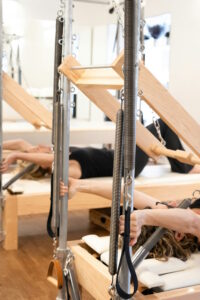
Pilates, a fitness system renowned for its focus on core strength, flexibility, and overall body awareness, often incorporates specialized equipment to enhance the effectiveness of its exercises. In this comprehensive guide, we will explore the various types of Pilates equipment, their functions, and their role in Pilates practice, addressing common questions and demystifying the world of Pilates apparatus.
What equipment do I need to start Pilates at home?
Starting Pilates at home is a feasible and convenient option, even if you don’t have access to the full range of studio equipment. Here’s a list of essential equipment to begin your home Pilates practice:
1. Pilates Mat: A high-quality Pilates or yoga mat provides cushioning and support during mat-based exercises.
2. Resistance Bands: Resistance bands come in varying levels of resistance and are versatile for adding resistance to your Pilates movements.
3. Pilates Magic Circle: This small, flexible ring adds resistance to leg and arm exercises, helping tone and strengthen muscles.
4. Pilates Ball: A small inflatable ball can be used to challenge stability and engage core muscles in various exercises.
5. Pilates DVDs or Online Classes: Access to instructional videos or online classes led by certified Pilates instructors can guide your home practice.
While studio equipment like reformers and Cadillac machines can enhance your Pilates experience, you can establish a solid foundation with these basic items for home practice.
Which is the most popular and best-known equipment of Pilates?
The most iconic and well-known piece of Pilates equipment is the Reformer. The Pilates Reformer is a versatile apparatus that offers a wide range of resistance-based exercises. It consists of a frame, a carriage that moves back and forth, and adjustable springs that provide resistance.
Key features of the Reformer include:
· Adjustability: The Reformer’s springs can be adjusted to modify resistance levels, making it suitable for various fitness levels.
· Full-Body Workout: It allows for a comprehensive full-body workout, targeting different muscle groups with exercises for strength, flexibility, and coordination.
· Sliding Carriage: The moving carriage challenges balance and control, engaging core muscles throughout the exercises.
· Straps and Handles: Straps and handles provide leverage for arm and leg exercises, allowing for an extensive repertoire of movements.
While the Reformer is the most iconic, other popular Pilates equipment includes the Cadillac (also known as the Trapeze Table), the Wunda Chair, and the Ladder Barrel, each offering unique benefits and exercise variations.
Why is Pilates equipment so expensive?
Pilates equipment, particularly the high-quality, studio-grade apparatus, can be costly for several reasons:
1. Precision Engineering: Pilates equipment is engineered with precision to ensure smooth and controlled movements, requiring durable materials and meticulous craftsmanship.
2. Quality Materials: To withstand regular use and maintain safety, Pilates equipment is constructed from high-quality, durable materials, such as solid wood, steel, and padded leather.
3. Customization: Many pieces of Pilates equipment, like the Reformer, offer adjustable components to accommodate various body sizes and fitness levels, adding to the production cost.
4. Certification and Training: Pilates equipment is often used under the guidance of certified instructors who undergo rigorous training, adding to the overall investment in the practice.
5. Specialized Production: The production of Pilates equipment is often specialized and may involve smaller manufacturers, resulting in higher manufacturing costs.
While the initial expense can be significant, investing in quality Pilates equipment ensures safety, durability, and a more rewarding Pilates experience.
What equipment do you use in Pilates?
In a Pilates studio, you’ll find a variety of equipment designed to target specific muscle groups and enhance your practice. Some of the most common pieces of Pilates equipment include:
1. Reformer: The Reformer is a versatile apparatus that provides resistance and support for a wide range of exercises.
2. Cadillac (Trapeze Table): This apparatus features a table with various attachments like bars, straps, and springs, offering exercises for flexibility and strength.
3. Wunda Chair: The Wunda Chair is a compact apparatus with a spring-loaded pedal for resistance, used for seated and standing exercises.
4. Ladder Barrel: The Ladder Barrel consists of a barrel shape with a ladder, providing support for stretching and strengthening exercises.
5. Pilates Mat: While not equipment in the traditional sense, a Pilates mat is essential for mat-based exercises and provides cushioning and support.
6. Small Props: Pilates often incorporates small props like the Magic Circle, resistance bands, balls, and foam rollers to add variety and challenge to exercises.
The choice of equipment in a Pilates session depends on your goals, instructor’s guidance, and your level of experience. The combination of these apparatuses offers a well-rounded and customizable Pilates experience.
In summary, Pilates equipment plays a crucial role in enhancing the effectiveness of Pilates exercises, whether you’re practicing at home or in a studio. While the Reformer stands out as the most iconic piece, other apparatuses like the Cadillac, Wunda Chair, and Ladder Barrel offer unique benefits and exercise variations. While Pilates equipment can be expensive due to its precision engineering and quality materials, the investment in your Pilates practice can provide long-lasting benefits in terms of physical fitness and overall well-being.